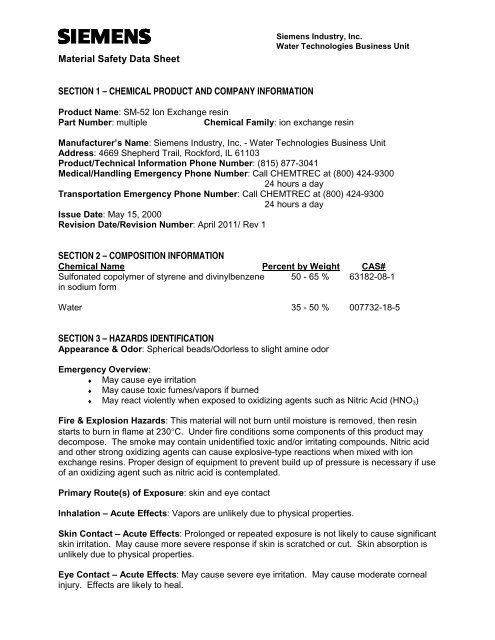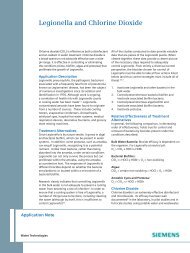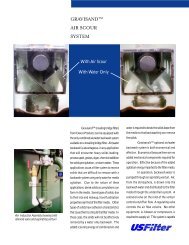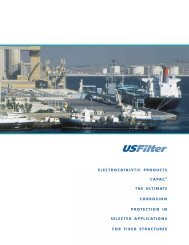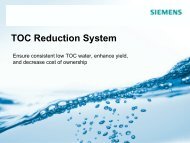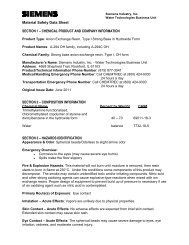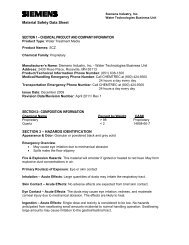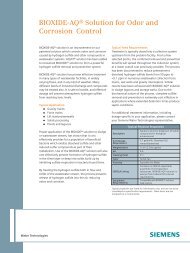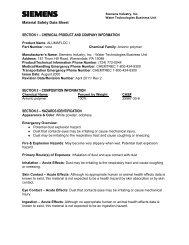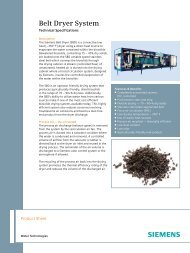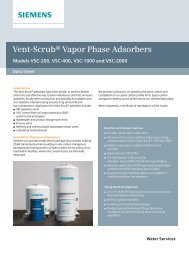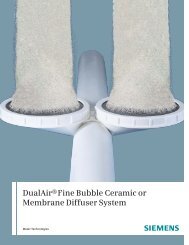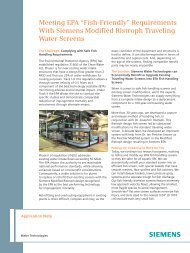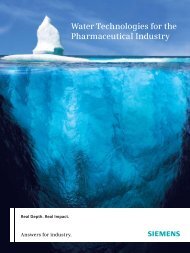Ion Exchange Resin SM-52.pdf - Siemens Water Technologies
Ion Exchange Resin SM-52.pdf - Siemens Water Technologies
Ion Exchange Resin SM-52.pdf - Siemens Water Technologies
Create successful ePaper yourself
Turn your PDF publications into a flip-book with our unique Google optimized e-Paper software.
Material Safety Data Sheet<strong>Siemens</strong> Industry, Inc.<strong>Water</strong> <strong>Technologies</strong> Business UnitSECTION 1 – CHEMICAL PRODUCT AND COMPANY INFORMATIONProduct Name: <strong>SM</strong>-52 <strong>Ion</strong> <strong>Exchange</strong> resinPart Number: multipleChemical Family: ion exchange resinManufacturer’s Name: <strong>Siemens</strong> Industry, Inc. - <strong>Water</strong> <strong>Technologies</strong> Business UnitAddress: 4669 Shepherd Trail, Rockford, IL 61103Product/Technical Information Phone Number: (815) 877-3041Medical/Handling Emergency Phone Number: Call CHEMTREC at (800) 424-930024 hours a dayTransportation Emergency Phone Number: Call CHEMTREC at (800) 424-930024 hours a dayIssue Date: May 15, 2000Revision Date/Revision Number: April 2011/ Rev 1SECTION 2 – COMPOSITION INFORMATIONChemical Name Percent by Weight CAS#Sulfonated copolymer of styrene and divinylbenzene 50 - 65 % 63182-08-1in sodium form<strong>Water</strong> 35 - 50 % 007732-18-5SECTION 3 – HAZARDS IDENTIFICATIONAppearance & Odor: Spherical beads/Odorless to slight amine odorEmergency Overview:♦ May cause eye irritation♦ May cause toxic fumes/vapors if burned♦ May react violently when exposed to oxidizing agents such as Nitric Acid (HNO 3 )Fire & Explosion Hazards: This material will not burn until moisture is removed, then resinstarts to burn in flame at 230°C. Under fire conditions some components of this product maydecompose. The smoke may contain unidentified toxic and/or irritating compounds. Nitric acidand other strong oxidizing agents can cause explosive-type reactions when mixed with ionexchange resins. Proper design of equipment to prevent build up of pressure is necessary if useof an oxidizing agent such as nitric acid is contemplated.Primary Route(s) of Exposure: skin and eye contactInhalation – Acute Effects: Vapors are unlikely due to physical properties.Skin Contact – Acute Effects: Prolonged or repeated exposure is not likely to cause significantskin irritation. May cause more severe response if skin is scratched or cut. Skin absorption isunlikely due to physical properties.Eye Contact – Acute Effects: May cause severe eye irritation. May cause moderate cornealinjury. Effects are likely to heal.
Material Safety Data Sheet<strong>Siemens</strong> Industry, Inc.<strong>Water</strong> <strong>Technologies</strong> Business UnitIngestion – Acute Effects: Single dose oral toxicity is considered to be low. No hazardsanticipated from swallowing small amounts incidental to normal handling operation.SECTION 4 – FIRST AID MEASURESInhalation First Aid: Remove affected person from area to fresh air and provide oxygen ifbreathing is difficult. Give artificial respiration ONLY if breathing has stopped and give CPRONLY if there is no breathing and no pulse. Obtain medical attention. No adverse effectsanticipated by this route of exposure.Skin Contact First Aid: Immediately remove clothing from affected area and wash skinvigorously with flowing water. Clothing should be washed before reuse. DO NOT instruct personto neutralize affected skin area.Eye Contact First Aid: Immediately irrigate eyes with flowing water continuously for 15 minuteswhile holding eyes open. Contacts should be removed before or during flushing. Obtain medicalattention. DO NOT instruct person to neutralize.Ingestion First Aid: No adverse effects anticipated by this route of exposure incidental toproper industrial handling. If ingestion does occur, if victim is alert and not convulsing rinsemouth with water and give plenty of water to drink. If spontaneous vomiting occurs, haveaffected person lean forward with head down to avoid breathing in of vomitus. Rinse mouthagain and give more water to drink. Obtain medical attention.Medical Conditions Aggravated: There are no known conditions aggravated by exposure.Note to Physician: No specific antidote. Supportive care. Treatment based on judgment of thephysician in response to reactions of the patient.SECTION 5 – FIRE FIGHTING MEASURESFlash Point/Method: Not applicable.Auto Ignition Temperature: Above 500°C (900°F)Upper/Lower Explosion Limits: Not applicable.Extinguishing Media: <strong>Water</strong>, carbon dioxide, dry chemicalFire Fighting Procedures: Keep people away. Isolate fire area and deny unnecessary entry.Cool surrounding area with water to localize fire zone. Soak thoroughly with water to cool andprevent reignition.Fire-Fighting Equipment: NIOSH approved positive-pressure self-contained breathingapparatus (SCBA) and protective fire fighting clothing (includes fire fighting helmet, coat, pants,boots and gloves). If protective equipment is not available or not used, fight fire from aprotected location or a safe distance.Page 2 of 6
Material Safety Data Sheet<strong>Siemens</strong> Industry, Inc.<strong>Water</strong> <strong>Technologies</strong> Business UnitFire & Explosion Hazards: This material will not burn until moisture is removed, then resinstarts to burn in flame at 230°C. Under fire conditions some components of this product maydecompose. The smoke may contain unidentified toxic and/or irritating compounds. Nitric acidand other strong oxidizing agents can cause explosive-type reactions when mixed with ionexchange resins. Proper design of equipment to prevent build up of pressure is necessary if useof an oxidizing agent such as nitric acid is contemplated.Hazardous Products of Decomposition and/or Combustion: May include but not limited tohydrocarbons, sulfur oxides, organic sulfonates, carbon monoxide, carbon dioxide and benzenecompounds.NFPA Ratings:HEALTH- 1 FLAMMABILITY- 1 REACTIVITY- 1 OTHER- noneSECTION 6 – ACCIDENTAL RELEASE MEASURESSpill/Leak Procedures: Isolate spill area to prevent falls as material can be a slipping hazard.Avoid contact with eyes and skin. Material is heavier than water and has limited water solubility.It will collect on the lowest surface.Cleanup: Clean up floor area. Sweep up.Regulatory Requirements: Follow all applicable Federal, State, Local, or Provincial regulations.Disposal: DO NOT DUMP INTO ANY SEWERS, ON THE GROUND, OR INTO ANY BODY OFWATER. All disposal methods must be in compliance with all Federal, State, Local andProvincial laws and regulations. Regulations may vary in different locations. Wastecharacterizations and compliance with applicable laws are the responsibility solely of the wastegenerator.SECTION 7 – HANDLING AND STORAGEHandling: Practice reasonable care and caution. Metal equipment should be compatible withfeed, regenerant, resin form and effluent of that process.Storage: Keep containers tightly closed when not in use. Store between 2° - 38°C (35° -100°F).General Comments: Containers of this material may be hazardous when empty since theyretain product residues (dust, solids); observe all warnings and precautions listed for theproduct.SECTION 8 –PERSONAL PROTECTION/ EXPOSURE CONTROLRespiratory Protection: No respiratory protection should be needed.Skin Protection: Use gloves impervious to this material when prolonged or frequently repeatedcontact could occur. If hands are cut or scratched, use gloves impervious to this material evenfor brief exposures.Page 3 of 6
Material Safety Data Sheet<strong>Siemens</strong> Industry, Inc.<strong>Water</strong> <strong>Technologies</strong> Business UnitEye Protection: Wear protective eyeglasses or chemical safety goggles. Contact lenses arenot eye protective devices. Appropriate eye protection must be worn instead of, or inconjunction with contact lenses.Ventilation Protection: Good general ventilation should be sufficient.Other Protection: Never eat, drink, or smoke in work areas. Practice good personal hygieneafter using this material, especially before eating, drinking, smoking, using the toilet, or applyingcosmetics.Safety showers, with quick opening valves which stay open, and eye wash fountains, or othermeans of washing the eyes with a gentle flow of cool to tepid tap water, should be readilyavailable in all areas where this material is handled or stored. <strong>Water</strong> should be supplied throughinsulated and heat-traced lines to prevent freeze-ups in cold weather.Exposure Limits:Exposure limits have not been developed.SECTION 9 – PHYSICAL AND CHEMICAL PROPERTIESAppearance & Odor: Spherical beads/Odorless to slight amine odorVapor Pressure: N/A*Boiling Point: N/ASpecific Gravity: N/D**Volatile Percentage: N/AFlash Point/method: N/AVapor Density (Air=1): N/AMelting Point: N/ASolubility in <strong>Water</strong>: InsolublepH: N/AAuto Ignition Temperature: Above 500°C (900°F)Upper/Lower Explosion Limits: N/A*N/A=Not applicable**N/D=Not determinedOther: noneSECTION 10 – STABILITY AND REACTIVITYStability: Stable under normal handling and storage conditions.Incompatibilities: Oxidizing agents such as nitric acid attack organic ion exchange resinsunder certain conditions and could result in slightly degraded resin up to an explosive reaction.Before using strong oxidizing agents, consult sources knowledgeable in handling suchmaterials.Polymerization: Hazardous polymerization cannot occur.Page 4 of 6
Material Safety Data Sheet<strong>Siemens</strong> Industry, Inc.<strong>Water</strong> <strong>Technologies</strong> Business UnitDecomposition: Hazardous decomposition products depend upon temperature, air supply,and the presence of other materials. Hazardous decomposition products may include and arenot limited to: aromatic compounds, hydrocarbons, organic sulfonates, sulfur oxides.Conditions to Avoid: <strong>Resin</strong> can decompose at temperatures greater than 90°C (194°F). Donot pack column with dry ion exchange resins. Dry beads expand when wet. This expansioncan cause a glass column to shatter.SECTION 11 – TOXICOLOGICAL INFORMATIONInhalation – Acute: Vapors are unlikely due to physical properties.Inhalation – Chronic: There are no known chronic inhalation effects.Skin Contact – Acute: Prolonged or repeated exposure is not likely to cause significant skinirritation. May cause more severe response if skin is scratched or cut. Skin absorption isunlikely due to physical properties.Skin Contact – Chronic: There are no known chronic dermal effects.Eye Contact – Acute: May cause severe eye irritation. May cause moderate corneal injury.Effects are likely to heal.Ingestion – Acute: Single dose oral toxicity is considered to be low. No hazards anticipatedfrom swallowing small amounts incidental to normal handling operation.Ingestion – Chronic: There are no known chronic ingestion effects.Carcinogenicity/Mutagenicity: There are no known carcinogenic/mutagenic effects.Reproductive Effects: There are no known reproductive effects.Neurotoxicity: There are no known neurotoxic effects.Other Effects: There are no other known toxic effects.Target Organs: This product will affect the eyes.SECTION 12 – ECOLOGICAL INFORMATIONThe environmental fate and ecological toxicity are not known.SECTION 13 – DISPOSAL CONSIDERATIONSSpill/Leak Procedures: Isolate spill area to prevent falls as material can be a slipping hazard.Avoid contact with eyes and skin. Material is heavier than water and has limited water solubility.It will collect on the lowest surface.Cleanup: Clean up floor area. Sweep up.Regulatory Requirements: Follow all applicable Federal, State, Local, or Provincial regulations.Page 5 of 6
Material Safety Data Sheet<strong>Siemens</strong> Industry, Inc.<strong>Water</strong> <strong>Technologies</strong> Business UnitDisposal: DO NOT DUMP INTO ANY SEWERS, ON THE GROUND, OR INTO ANY BODY OFWATER. All disposal methods must be in compliance with all Federal, State Local andProvincial laws and regulations. Regulations may vary in different locations. Wastecharacterizations and compliance with applicable laws are the responsibility solely of the wastegenerator.SECTION 14 – TRANSPORTATION INFORMATIONDOT Shipping Description: This product is not regulated by DOT when shipped domesticallyby land.Canadian TDG Information: For TDG regulatory information, if required, consult transportationregulations, or product shipping papers.SECTION 15 – REGULATORY INFORMATIONUS Regulations:SARA HAZARD CATEGORY: This product has been reviewed according to the EPA "HazardCategories" promulgated under Sections 311 and 312 of the Superfund Amendment andReauthorization Act of 1986 (SARA Title III) and is considered, under applicable definitions, tomeet the following categories: An immediate health hazardTSCA Considerations: Every different salt or ionic form of an ion exchange resin is a separatechemical. If you use an ion exchange resin for ion exchange purposes and then remove the byproductresin from its vessel or container prior to recovery of the original or another form of theresin or of another chemical, the by-product resin must be listed on the TSCA Inventory (Unlessan exemption is applicable). It is the responsibility of the customer to ensure that such isolated,recycled by-product resins are in compliance with TSCA. Failure to comply could result insubstantial civil or criminal penalties being assessed by the EPA.State Regulations: Consult individual state agency for further information.Canadian Regulations:WHMIS INFORMATION: The Canadian Workplace Hazardous Materials InformationSystem (WHMIS) Classification for this product is: D2B - eye or skin irritant. Refer elsewhere inthe MSDS for specific warnings and safe handling information.CPR Statement: This product has been classified in accordance with the hazard criteria of theCanadian Controlled Products Regulations (CPR) and the MSDS contains all the informationrequired by the CPR.SECTION 16 – OTHER INFORMATIONDisclaimer: The information contained herein is based on data considered accurate. However,no warranty is expressed or implied regarding the accuracy of these data or the results to beobtained from the user thereof. It is the buyer’s responsibility to ensure that its activities complywith federal, state, provincial and local laws.Revision Indicator: April 2011, Revised Section 1 (Updated manufacturer’s name)Page 6 of 6


